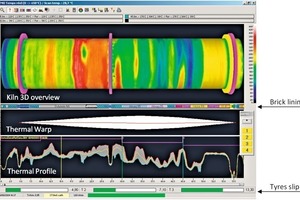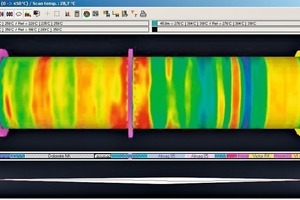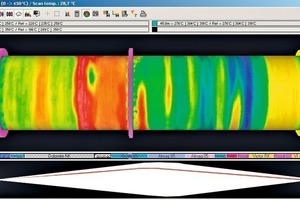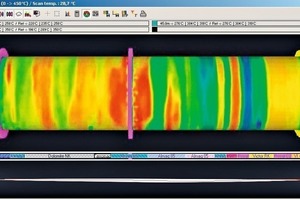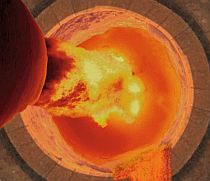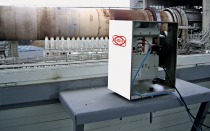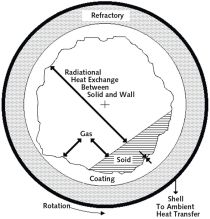The maxim “health is wealth” is applicable to the cement kiln, too. As long as the shell is rotating, the level of profitability is high. Every time a kiln is stopped, a drop in revenue occurs. So the choice of the best monitoring tools providing trust indicators before serious failures occur, is essential. The HGH thermal scanner Kilnscan, enabling continuous surveillance of kiln shell temperature, has a central position in the control room of hundreds of modern cement plants around the world. One of the unique advanced features of Kilnscan is the thermal warp computation. The thermal warp analysis is made available to the operator for
protecting the kiln and its equipment through a better control of mechanical and thermo-mechanical stresses and
keeping trace of the kiln thermo-mechanical behavior when operating conditions are altered (flame, meal flow rate, kiln rotation speed, gas draught).
Principle
The system consists of calculating the kiln distortion induced by temperature changes over the shell in order to infer the cyclical overloads and associated stresses suffered by the shell, tyres and roller stations. The kiln thermo-mechanical distortion is calculated in real time from the shell thermal map drawn up by the shell infrared scanner.
The system works from the real-time synchronous acquisition of the following measurements:
kiln shell temperature, by the infrared scanner,
synchronisation by kiln rotation contact switch,
tyre slippage (Fig. 1).
From the screen menu, the operator can display:
the shell thermal chart and thermal profile from the most recent temperature measurement,
the configuration of thermal warp analysis.
At a pre-selected period (for example 30 minutes), the system displays automatically:
the shell temperature fluctuations along the kiln
the thermal non-axisymmetrical distortion of the kiln
the clearance between tyres and shell.
Advantages
The evolution of the thermal non-axisymmetrical distortion of the kiln provides information on the process evolution inside the kiln: evolution of coatings, kiln push of unburnt material, flame adjustment, etc. The actions taken to solve process anomalies react very quickly on the shell distortion, the clearance between tyres and shell, and of course the shell temperature.
Figures 2–4 show the thermal distortion fluctuation during the process evolution: after a hot spot detection due to unburnt material, the operator modified the flame adjustment and the rotation speed, to adapt the burning conditions and to homogenize the coating, resulting in decrease of the distortion.
The kiln manufacturer is able to determine:
mechanical and thermal stresses in the shell and the tyres,
load fluctuation supported by each pier,
shell and tyres out-of-round,
thermal loading and construction stresses in the shell and the tyres,
hertz pressure fluctuation between tyres and rollers,
shrinkage stress fluctuations in the rollers,
bending stresses in the roller shafts,
specific pressure fluctuation on the roller bearings;
and to evaluated the risks of mechanical failures such as:
risk of hot spots under the tyres,
risk of excessive shell out-of-roundness under the tyres,
risk of tyre constriction on the shell,
risk of breakage of the tyres according to the fatigue criteria,
risk of rollers slackening on the shaft,
risk of rollers and scaling off,
risk of bearing bushes seizing.
Conclusions
Thermal warp calculation and display is a user friendly tool which assists the operator to select the correct kiln operating settings. It also enables detection of mechanical anomalies when analysis by the kiln supplier is involved. This function was jointly developed with FCB, Lafarge and HGH. HGH’s thermal scanner is a complete diagnostic tool, which not only shows hot spot formation on kiln surface just after the fall of a single refractory brick, but warns effectively of potential risks sufficiently in advance to enable positive corrective actions to be taken. This is the key benefit that HGH Kilnscan can bring to kiln operators in cement plants.
www.hgh.fr

